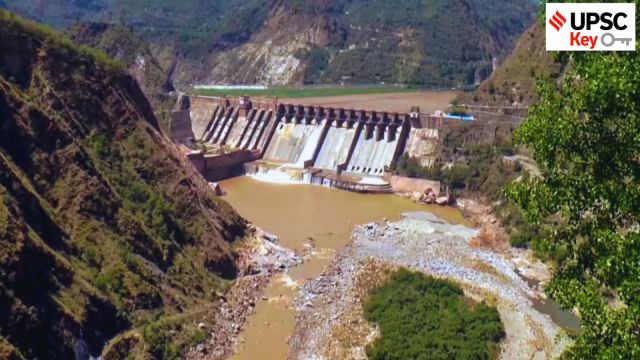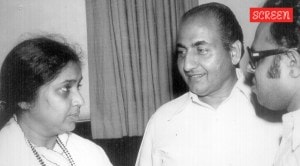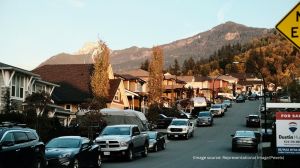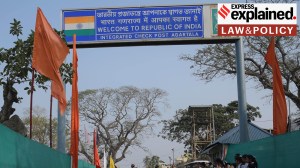
Preliminary Examination: Current events of national and international importance.
Main Examination: General Studies-II, III: India and its neighbourhood- relations. Bilateral, regional and global groupings and agreements involving India and/or affecting India’s interests. Role of external state and non-state actors in creating challenges to internal security. Security challenges and their management .
Story continues below this ad
What’s the ongoing story: Moving swiftly a day after it formally informed Pakistan that the Indus Waters Treaty (IWT) was being suspended with immediate effect, the government Friday looked at the options available to utilise the waters of the Indus basin rivers in the short, medium and long terms.
Key Points to Ponder:
• Read about the 2025 Pahalgam terror attack.
• What is the 5-Point Action Plan Announced by India After the Pahalgam Terror Attack?
• What is the Indus Waters Treaty (IWT)?
• What are the hydroelectric projects in Jammu and Kashmir that have been a bone of contention between India and Pakistan?
• What are the immediate diplomatic actions India took following the Pahalgam terror attack?
• What is the Vienna Convention on Diplomatic Relations?
• What is the ceasefire agreement between India and Pakistan?
• What is the history of India-Pakistan ties?
• What do you understand by the term “electronic signature”?
• What is terrorism?
• What are non-state actors?
Story continues below this ad
• Compare and contrast the defense capabilities of India and Pakistan in 2025.
• What is Line of Control?
• Map work: Indian states Bordering Pakistan (Refer Atlas)
Key Takeaways:
• Jal Shakti Minister C R Patil said, “We will ensure that not even a drop of water from the Indus river goes to Pakistan.” The decision to pause the IWT was one among a series of measures against Pakistan in the wake of the Pahalgam terror attack in which 26 civilians were killed on April 22.
• At a meeting in New Delhi, Union Home Minister Amit Shah, Jal Shakti Minister Patil, Power Minister Manohar Lal were briefed by officials on the options available to the government following the suspension of the IWT.
• The officials, it is learnt, made a presentation, drawing attention to options that could be exercised in the short term, medium term and long term to utilise the waters of the Indus basin rivers. The government is exploring all legal and technical aspects of possible measures, including diversion of water, that can be taken in the near future.
Story continues below this ad
• The IWT was signed in Karachi on September 19, 1960, following nine years of negotiations between India and Pakistan. According to provisions of the Treaty, all the water of the “Eastern Rivers” of the Indus system – Sutlej, Beas and Ravi – would be available for the “unrestricted use” of India. Pakistan would receive water from the “Western Rivers” – Indus, Jhelum and Chenab.
• The decision to suspend the IWT gives Delhi more options on how to use the waters of the Indus river system. On Wednesday, a day after the Pahalgam attack, the Cabinet Committee on Security (CCS) decided to keep the IWT in abeyance. On Thursday, India formally informed Pakistan that it was pausing the IWT with immediate effect.
• The Pakistan government decided Friday to halt the contentious canals project after India decided to suspend the IWT.
Do You Know:
From “Technical intelligence, credible inputs have confirmed Pakistan link: Delhi to foreign govts”
Story continues below this ad
• A combination of “technical intelligence” and “credible information” from intelligence sources including critical eyewitnesses has confirmed the identity of the Pahalgam attack terrorists and established the Pakistan “link”, New Delhi has conveyed to the international community over the past two days, The Indian Express has learnt.
• This has been part of some of Prime Minister Narendra Modi’s phone calls with 13 world leaders, and meetings in Delhi between more than 30 ambassadors and Foreign Secretary Vikram Misri and other senior officials in the Ministry of External Affairs.
• Foreign leaders and envoys have been told that the “electronic signature” of the terrorists and the terror group, The Resistance Front, has been traced to at least two locations in Pakistan, it is learnt.
• Delhi has launched a series of diplomatic retaliatory steps against Pakistan, and officials have justified these steps to their foreign counterparts, saying there is enough material that establishes Pakistan’s involvement in the attack.
Other Important Articles Covering the same topic:
Story continues below this ad
📍Knowledge Nugget | What should you know about the Pahalgam terror attack and the Indus Waters Treaty of 1960 for the UPSC Exam?
📍Knowledge Nugget: How is Vienna Convention on Diplomatic Relations relevant for UPSC Exam?
Previous year UPSC Prelims Question Covering similar theme:
(1) With reference to the Indus river system, of the following four rivers, three of them pour into one of them which joins the Indus directly. Among the following, which one is such a river that joins the Indus direct? (UPSC CSE 2021)
(a) Chenab
(b) Jhelum
(c) Ravi
(d) Sutlej
Previous year UPSC Main Question Covering similar theme:
“Increasing cross-border terrorist attacks in India and growing interference in the internal affairs of several member-states by Pakistan are not conducive for the future of SAARC (South Asian Association for Regional Cooperation).” Explain with suitable examples. (UPSC CSE 2016)
Story continues below this ad
GOVT & POLITICS
Syllabus:
Preliminary Examination: Current events of national and international importance
Mains Examination: General Studies-II, III: Bilateral, regional and global groupings and agreements involving India and/or affecting India’s interests, Security challenges and their management.
What’s the ongoing story: India is set to sign a deal on procuring 26 Rafale-Marine (Rafale-M) fighter jets for the Indian Navy from France on Monday, that is estimated to cost around `63,000 crore, sources have said.
Key Points to Ponder:
• Read about the Rafale-Marine (Rafale-M) fighter jets.
• What is the significance of India’s deal on procuring Rafale-M fighter jets for the operational capabilities of the Indian Navy?
Story continues below this ad
• What are the areas of cooperation between India and France?
• What is the Cabinet Committee on Security (CCS)?
• What are the challenges India faces in achieving self-reliance in defence production?
• What are the different types of aircraft that India has?
• Read about the INS Vikramaditya and INS Vikrant.
Key Takeaways:
• The government-to-government deal is being signed by the Defence ministers remotely. But the signing ceremony will be presided by Defence Secretary Rajesh Kumar Singh and French ambassador Thierry Mathou. Some government-to-business agreements will be signed on Monday as well.
Story continues below this ad
• This follows the approval by the Cabinet Committee on Security (CCS), headed by Prime Minister Narendra Modi, in early April when they gave the final nod for the procurement of 26 Rafale-M fighter jets from France for the Indian Navy.
• Sources said that the Rafale-M jets include 22 single-seater jets that can operate from aircraft carriers and four twin-seater trainer jets, which are not carrier-compatible. The delivery of the jets will begin in 2028-29 after the contract is signed and is expected to be completed by 2031-32.
• The Rafale-M fighter jets would come along with associated ancillary equipment, weapons, simulator, spares, documentation, crew training and logistic support. Their procurement from the French Government is on an Inter-Governmental Agreement (IGA) basis.
• With the MiG-29 Ks slated to be phased out in the next few years, procuring the jets is an interim arrangement for the Navy’s aircraft carriers—INS Vikramaditya (procured from Russia) and indigenously-built INS Vikrant—till it acquires the indigenous Twin Engine Deck-Based Fighter which is currently under development by Aeronautical Development Agency under the DRDO.
• The Rafale jets, which were acquired after the Balakot aerial strike, have added to the Indian Air Force’s firepower. The 36 Rafael fighter jets have been stationed in India’s strategic air bases bordering Pakistan and China. The two sides have always prioritised co-production, co-development of military hardware with a focus on India’s self-reliance goals.
Do You Know:
• With the Prime Minister helming it, the Cabinet Committee on Security (CCS) has the ministers for Finance, Defence, Home Affairs and External Affairs as its members. It is responsible for debates, discussions and appointments of/ in the national security bodies.
• Major decisions with respect to the significant appointments, issues of national security, defence expenditure of India are taken by CCS. Besides dealing with defence related issues, the CCS also brainstorms on issues relating to law and order and internal security, and policy matters concerning foreign affairs on security-related issues. It also considers matters relating to atomic energy.
Other Important Articles Covering the same topic:
📍What the Rafale M deal means for Indian Navy — and what it misses
📍CCS approves Rs 64,000-crore deal to procure 26 Rafale-M jets for Navy
UPSC Prelims Practice Question Covering similar theme:
(2) The Rafale-M jets for the Indian Navy will primarily operate from which aircraft carriers?
(a) INS Chakra and INS Kalvari
(b) INS Viraat and INS Vishal
(c) INS Arihant and INS Arighat
(d) INS Vikrant and INS Vikramaditya
EXPLAINED
Syllabus:
Preliminary Examination: Current events of national and international importance.
Main Examination: General Studies-II, III: India and its neighbourhood- relations. Bilateral, regional and global groupings and agreements involving India and/or affecting India’s interests. Security challenges and their management .
What’s the ongoing story: In retaliation to the Pahalgam terror attack, India has decided to hold the Indus Waters Treaty of 1960 (IWT) “in abeyance”, and announced a slew of other diplomatic measures. Pakistan too has said that it “shall exercise the right to hold all bilateral agreements with India, including but not limited to the Simla Agreement, in abeyance.”
Key Points to Ponder:
• What is the history of India-Pakistan ties?
• Read about the 5-Point Action Plan Announced by India After the Pahalgam Terror Attack.
• What is the Indus Waters Treaty (IWT)?
• What is the dispute resolution process enshrined in the IWT?
• Read about the India-Pakistan War of 1971.
• What is the Simla Agreement? Does it mention a dispute resolution process?
• Read about the LoC.
• What is the Vienna Convention on the Law of Treaties of 1969 (VCLT)?
• What are the security challenges faced by India on the LoC?
Key Takeaways:
• Holding treaties “in abeyance” often have significant ramifications on the ground. In the case of the IWT and the Simla Agreement, however, the immediate impact will be limited.
• The IWT guides the distribution of the waters of the Indus and its tributaries between India and Pakistan. On Thursday, India formally informed Pakistan that the treaty will be “held in abeyance” with immediate effect.
• Now, the IWT itself states that the treaty cannot be altered unilaterally. Article XII of the IWT says that the treaty can only be terminated “by a duly ratified treaty concluded for that purpose between the two Governments”. The article also says that it “may from time to time be modified by a duly ratified treaty concluded for that purpose between the two Governments”.
• In its letter to Pakistan on Thursday, India invoked the provision for modification under Article XII (3). “These communications cited fundamental changes in the circumstances that have taken place since the Treaty was executed that require a reassessment of obligations under the various Articles of the Treaty read with its Annexures,” the letter by the Jal Shakti Ministry stated.
• According to the letter, the “changes” include “significantly altered population demographics”, “the need to accelerate the development of clean energy”, and Pakistan not acting in “good faith”. “The obligation to honour a treaty in good faith is fundamental to a treaty. However, what we have seen instead is sustained cross border terrorism by Pakistan,” the letter said.
• In international law, terms like “fundamental changes in the circumstances” and (the lack of) “good faith” allow countries to rescind their consent from agreements.
• The term “hold in abeyance” is not recognised in international law, and it does not find a mention in the Vienna Convention on the Law of Treaties of 1969 (VCLT), a multilateral treaty which regulates treaties among nations.
• The Simla agreement signed in 1972, in the aftermath of the 1971 India-Pakistan war (which Pakistan lost), primarily deals with two things: how bilateral relations are to be conducted between the two countries, and the recognition of the Line of Control (LoC) as the de facto border.
• “Pending the final settlement of any of the problems between the two countries, neither side shall unilaterally alter the situation and both shall prevent… any acts detrimental to the maintenance of peaceful and harmonious relations,” the agreement states.
• These are not legally binding obligations, but contain what is commonly referred to as “best endeavour clauses” which both countries agreed to.
• But Pakistan has never truly endeavoured to abide by the agreement — it has repeatedly violated the ceasefire, tried to annex positions on the Indian side of the LoC in Kargil in 1999, and frequently sponsored non-state actors to breach India’s sovereignty.
• For all intents and purposes, the Simla Agreement has been dead for a long time. In fact, even the ongoing suspension of talks between the two nations can be seen as a breach of the Simla Agreement. Pakistan suspending the treaty only means that it no longer recognises the LoC.
Do You Know:
• The VCLT recognises circumstances for “termination” or “suspension” of treaties. Article 62 states that “fundamental change of circumstances” may be ground for terminating a treaty under some conditions.
• But the International Court of Justice (ICJ), in its rulings, has set a rather high bar for what constitutes a “fundamental change”. Take for instance the ICJ’s ruling in Nicaragua v United States (1984). Nicaragua had taken the US to the ICJ for supporting anti-communist Contra rebels, which the central American country argued violated the United States’ obligations under the 1956 Treaty of Friendship, Commerce and Navigation. The US claimed that there had been a fundamental change in circumstances — namely the communist takeover by Sandinistas — that warranted a “need for collective self-defense”. The ICJ rejected this argument.
• The IWT dispute-resolution mechanism under the IWT has three tiers. The first, involves the Permanent Indus Commission, set up under the treaty. The second, involves a neutral expert to be appointed by the World Bank. If she too fails to come up with an acceptable resolution, then the matter can be escalated to the Permanent Court of Arbitration (PAC).
Other Important Articles Covering the same topic:
📍Pakistan suspends Simla Agreement: What is the pact Indira Gandhi, Zulfikar Ali Bhutto signed in 1972?
📍Pahalgam terror attack | Indus abeyance is official, all visas cancelled: Delhi turns the screws
Previous year UPSC Prelims Question Covering similar theme:
(3) Arrange the following agreements between India and Pakistan in chronological order:
1. Tashkent Declaration
2. Indus Water Treaty
3. Agreement on the Prohibition of Attack Against Each Other’s Nuclear Installations and Facilities
4. Agreement on Reducing the Risk from Accidents Relating to Nuclear Weapons
Select the correct answer using the code given below: (UPSC-CDS (II) – 2024)
(a) 1, 2, 3, 4
(b) 2, 3, 4, 1
(c) 2, 1, 3, 4
(d) 1, 4, 2, 3
Previous year UPSC Mains Question Covering similar theme:
Terrorist activities and mutual distrust have clouded India – Pakistan relations. To what extent the use of soft power like sports and cultural exchanges could help generate goodwill between the two countries? Discuss with suitable examples. ( UPSC CSE 2015)
Syllabus:
Preliminary Examination: Current events of national and international importance.
Main Examination: General Studies-II: Effect of policies and politics of developed and developing countries.
What’s the ongoing story: The Crimean peninsula had been “handed to” Vladimir Putin by Barack Obama, but now, “Crimea will stay with Russia”, United States President Donald Trump told Time Magazine in an interview published on Friday.
Key Points to Ponder:
• Read about the Russia-Ukraine war.
• Know in detail about the history of Crimea.
• What were the historical and geopolitical factors that led to the Russia-Ukraine war?
• What is the US stand on the Russia-Ukraine war?
• What is the significance of the Crimean Peninsula for Russia?
• What can be the international implications of the United States’ potential recognition of Crimea as Russian territory?
• What is the significance of Sevastopol port in Russia-Ukraine relations?
• Map work: Locate the Bosphorus Strait, Dardanelles Strait, Crimea , Russia, the Black Sea, the Mediterranean Sea, Sochi, Novorossiysk, Sevastopol, the Dnieper River and other places in the news with reference to the Russia and Ukraine war.
Key Takeaways:
• Earlier this week, Trump pressed Ukraine to accept a peace deal under which the US would reportedly recognise Crimea — which Russia seized in 2014 — as Russian territory. Formally accepting Crimea as part of Russia would reverse a major American foreign policy position.
• Experts have pointed out that while it may be acceptable — even reasonable under the circumstances — to concede an indefinite illegal occupation of Crimea, it is quite another thing to officially condone a change of Ukraine’s national borders by force.
• Importance of Crimea: Geography is a key determinant of what makes a place strategically valuable. At very few places in the world does this statement ring truer than in Crimea, whose strategic value arises not only out of its own geography, but that of the larger Russian Federation.
1. QUEST FOR WARM WATER PORTS: Russia’s coastline stretches more than 37,000 km. However, much of it is to the north of the Arctic Circle, where sea ice makes many Russian ports unusable in the winter. As such, the quest for warm water ports has guided centuries of Russian foreign policy. “The history of Russia may be written in terms of its search for ocean ports. The Russian Bear will not be content until it finds warm water…,” the geographer George Babcock Cressey wrote in his influential book, The Basis of Soviet Strength (1945).
2. GATEWAY TO MEDITERRANEAN: The Black Sea is by far the warmest marine feature bordering Russia. It is also the only way for Russia to directly access the Mediterranean Sea — through the vital Turkish-controlled Bosphorus and Dardanelles straits — and by extension, southern Europe, Africa, West Asia, and beyond. Since the late 18th century, Russia has projected power and secured its access to the Mediterranean with its Black Sea Fleet military unit.
3. IMPORTANCE OF SEVASTOPOL: The Black Sea ports of Sochi and Novorossiysk, in the Krasnodar Krai in southern Russia, are fairly shallow and require ships to moor offshore. This makes them less-than-ideal bases for the Black Sea Fleet, unlike its historic home: the deep water port of Sevastopol in Crimea.

• Sevastopol lies at the heart of Crimea’s importance to Moscow, especially since the disintegration of the Soviet Union. In the 1990s, control over Sevastopol was central to the tensions between Russia and nascent Ukraine. Out of negotiations to manage these tensions arose the Kharkiv Pact of 1997, which gave Crimea to Ukraine but allowed Russia to keep control of Sevastopol until 2017. In 2010, the lease was extended up to 2042, before Russia pulled out of the treaty in 2014.
4. THE QUESTION OF WATER: Crimea is arid, with insufficient rainfall to meet the needs of its roughly 2.5 million population. So the erstwhile USSR had built the 400-km-long North Crimean Canal to carry the water of the Dnieper river from mainland Ukraine to the peninsula.
• Soon after Russia annexed Crimea in February-March 2014, Ukraine dammed the canal ahead of its entry into the peninsula. According to a study from 2015, the canal was supplying up to 85% of Crimea’s water at the time it was shut down.
• Two days after invading Ukraine in 2022, Russian forces blew up the dam on the canal. “In order to guarantee the supply of water in the long term, Putin wants to control the canal all the way to the Dnieper river, which means occupying the province of Kherson…,” Russia expert Peter Rutland wrote for Responsible Statecraft, the online magazine of the Washington-based Quincy Institute.
• The city of Kherson, on the western bank of the Dnieper, is currently under Ukrainian control. But Russia occupies much of the territory in the oblast to the east of the river — and effectively controls the fate of the North Crimean Canal.
• Crimea had been part of Russia’s empire for hundreds of years until 1954, when the Soviet leader Nikita Khruschev transferred control over the peninsula to Kyiv as a “gift”. Putin does not accept this, and Trump’s proposal backs and legitimises his position. By freezing Ukraine’s political map as it stands today, the US will secure Crimea — and the canal — for Moscow for the long term.
Do You Know:
• In 2014, a massive pro-Western political movement ousted then President Viktor Yanukovych of Ukraine, who was seen in his country as a Russian puppet. Yanukovych fled Ukraine on February 22 that year, and Russian forces took control of Crimean strategic sites days later.
• In mid-March 2014, after Crimean authorities declared independence and asked to join Russia, the peninsula was formally incorporated as part of Ukraine’s giant neighbour. Moscow’s action was guided by two primary considerations.
• FIRST, Russia wanted to secure control over Sevastopol. SECOND, the new pro-West dispensation that took power in Kyiv following the Maidan Revolution was expected to push to join NATO, as other former Warsaw Pact members including Romania and Bulgaria, also on the Black Sea, had already done.
• Ukraine joining the US-led, anti-Russia military alliance would leave Russia deeply vulnerable in the Black Sea, once regarded as a “Soviet lake”. Taking full control of Crimea was vital in the context of a possible future invasion of Ukraine, for which the peninsula would provide the required foothold and launchpad. Putin finally invaded eight years later — in February 2022. Apart from the larger insecurity with the possible expansion of NATO to its doorstep, Crimea played a crucial role in Russia’s decision.
Other Important Articles Covering the same topic:
📍US President Donald Trump says ‘Crimea will stay with Russia,’ and Zelenskyy ‘understands that’
Previous year UPSC Prelims Question Covering similar theme:
(4) Consider the following countries: (UPSC CSE 2023)
1. Bulgaria
2. Czech Republic
3. Hungary
4. Latvia
5. Lithuania
6. Romania
How many of the above-mentioned countries share a land border with Ukraine?
(a) Only two
(b) Only three
(c) Only four
(d) Only five
THE IDEAS PAGE
Syllabus:
Preliminary Examination: Current events of national and international importance
Mains Examination: General Studies-II: Bilateral, regional and global groupings and agreements involving India and/or affecting India’s interests.
What’s the ongoing story: Anil Sooklal writes- “This year marks the 70th anniversary of the first Asia-Africa summit, which took place in Bandung, Indonesia from April 18 to 24, 1955. Twenty-nine newly independent Asian and African countries met in what was a historical gathering of the leaders of the developing south, recently freed from the devastation brought upon their countries by the ravages of colonial rule. Bandung was to set in motion a new wave of south-south cooperation and solidarity and served as the precursor of the Non-Aligned Movement (NAM).”
Key Points to Ponder:
• What is the historical significance of the 1955 Bandung Conference in South-South cooperation?
• What is the Non-Aligned Movement (NAM)?
• Read about the Cold War.
• What is the relevance of NAM in today’s global political environment?
• “The rules-based multilateral system is under siege.” Critically examine this statement.
• What is the UN Security Council? What is the composition and mandate of the United Nations Security Council (UNSC)?
• Why is there a growing demand for reforming the UNSC?
• What do you understand about the term “Global South”?
Key Takeaways:
• “The conveners of the conference were driven by the common goals of seeking to chart a new course of sovereign, independent and collective action in addressing the most pressing challenges as newly independent, developing nations dissatisfied with being at the margins of the global stage.”
• “The reluctance and continued hegemonic actions by the former colonial overlords and other Western powers in their interactions with countries in Africa, Asia and Latin America served as a key factor in bringing the leaders together.”
• “The core principles that catalysed the coming together of Asian and African leaders are as relevant today as they were in 1955. These included political independence, mutual respect for sovereignty, non-aggression and non-interference in internal affairs.”
• “All the above principles echo the common resolve of leaders to work in cooperation and partnership in upholding and defending a rules-based global order underpinned by the purposes and principles of the United Nations Charter.”
• “However, the rules-based multilateral system is under siege. There is a major trust deficit especially among the major powers, contributing to the highly polarised world we live in. “Might is right” is the ruling mantra of the day. At a time when we need collective action to address the most pressing challenges facing humanity — from climate change to deepening levels of poverty and inequality, protracted conflicts and trade wars — the world is fragmenting into opposing camps.”
• “The UN in its current form is no longer fit for purpose. Repeated calls and numerous resolutions aimed at reforming the UN and its institutions have yielded no results.This paralysis of international organisations is most evident in the UN Security Council (UNSC).”
• “Despite the fact that most of the countries of the Global South were not present at the formation of the UN in June 1945, the leaders of the Bandung Conference recognised the centrality of the purposes and principles of the UN Charter and reiterated their commitment to multilateralism and a rules-based global order. The Asia-Africa Summit gave birth to a new paradigm of south-south cooperation.”
• “It demonstrated the need for the Global South to work together to champion its collective aspirations on the world stage. Despite Bandung, the subsequent founding of the NAM in 1961 and the G77 in 1964, the Global South continued to be on the margins of global geopolitics and geoeconomics.”
• “The economic rise of Global South countries — China, Brazil, India, Indonesia and South Africa, among others — over the past three decades has come with a tectonic change in the geopolitical and economic landscape. South-south cooperation has risen to the fore…In the current fractured and polarised world, the countries of the Global South have to proactively demonstrate leadership in forging new partnerships and alliances both among themselves as well as with like-minded Global North countries committed to addressing common challenges and shared interests.”
Do You Know:
• The UN Charter established six main organs of the United Nations, including the UN Security Council (UNSC). The UNSC is composed of 15 members: five permanent members — China, France, Russian Federation, the United States, and the United Kingdom — and 10 non-permanent members who are elected by the General Assembly. The non-permanent members are elected for two-year terms — so every year, the General Assembly elects five non-permanent members out of the total 10.
• From G20 countries pledging to reform the United Nations Security Council through a transformative reform that aligns it with the realities and demands of the 21st century to BRICS nations calling for making global governance more inclusive by reforming the major multilateral institutions such as the UN Security Council. One can see that from time to time, various groupings and nations have demanded reform in the UNSC.
Other Important Articles Covering the same topic:
📍The world order is in flux. Multipolarity, based on equitable principles, is needed
📍UPSC Issue at a Glance | Understanding UNSC: Composition, need for reform, and India’s claim for permanent membership
Previous year UPSC Prelims Question Covering similar theme:
(5) The Security Council of UN consists of 5 permanent members, and the remaining 10 members are elected by the General Assembly for a term of ( UPSC CSE 2009)
(a) 1 year
(b) 2 years
(c) 3 years
(d) 5 years
Syllabus:
Preliminary Examination: Current events of national and international importance.
Main Examination: General Studies-II, III: India and its neighbourhood- relations. Bilateral, regional and global groupings and agreements involving India and/or affecting India’s interests. Role of external state and non-state actors in creating challenges to internal security. Security challenges and their management .
What’s the ongoing story: Anju Gupta writes- “Any strategic analysis of the current situation vis-a-vis Pakistan needs to be based on four fundamental questions: Can we press control+alt+delete on Pakistan from India’s strategic vision of security, stability and prosperity for all her people? What is the current reality of the state of Pakistan? What is the current geopolitics of the region? Can India muster the patience to use global networks to navigate the complexities of Pakistan to establish peace with it?”
Key Points to Ponder:
• What is the history of India-Pakistan relations?
• What are the areas of conflict between both the countries?
• Read about the FATF.
• What are the immediate diplomatic actions India took following the Pahalgam terror attack?
• How can international pressure through institutions like the FATF be used to strategically tackle the challenges posed by Pakistan to India?
• How can India effectively use its global partnerships and public diplomacy to address the challenges posed by Pakistan?
• What measures has India taken to address the challenge of terrorism?
Key Takeaways:
• “A neighbour can’t just be wished away from the strategic vision of a nation like India that is steadily progressing on the path of growth and prosperity. Making peace with a neighbour is rewarding, pragmatic and smart politics — it is not a weakness. The current wars in Ukraine and Gaza are prime examples of failures to do so.”
• “Pakistan’s army has wielded extra-constitutional power for decades and fully controls its security and foreign policies… The army deliberately follows policies to harm neighbours and bring defensive retaliation upon itself. Then it publicly plays up the possibility of retaliation or the threat thereof in order to support its narrative that only the army, not the corrupt polity, can hold Pakistan together. This vicious cycle has continued for decades.”
• “At home, the army is seen as failing to ensure security in the border states of Balochistan and Khyber Pakhtunkhwa, where following the withdrawal of US troops from Afghanistan, hundreds of casualties among security forces are being reported annually. Hard targets such as army bases, cantonments and fortified headquarters are being frequently targeted by Pakistani militants.”
• “A new factor that Pakistan is trying to exploit is the chill between India and Bangladesh. The relatively weak dispensation in Dhaka may not be able to prevent the growth of the radical networks that Pakistan could nurture for its own interests. However, the coldness will harm both sides. Though China and India are pragmatically moving forward to resolve issues, as long as the Chinese forces continue to be active on our borders, it’s advantage Pakistan.
• “It is not hard to imagine that there will be security, intelligence, kinetic and diplomatic responses to the situation arising from the Pahalgam attack. However, it would be equally rewarding to tie Pakistan down with effective global partnerships. One partnership that succeeded in tying it down for three years was under the FATF regime.”
• “Under FATF pressure, the Pakistan army released Taliban co-founder Abdul Ghani Baradar to facilitate the US-Taliban talks in Doha. Big-ticket attacks on hard targets in Jammu and Kashmir decreased drastically from mid-2018 to early 2021, with the exception of the Pulwama attack.”
• “India’s regional and global strategic partnerships can also be moved to address the realities of Pakistan and generate the combined resources that can get Pakistan to give up its policy of proxy wars. This will be a long haul and will require mature public diplomacy within and outside India, even as other institutions continue to play their part in defending the country. The reality is that Pakistan can neither be wished away nor looked at in isolation. In an increasingly interconnected world, India can surely tap into its networks and strengths to deal squarely with Pakistan.”
Other Important Articles Covering the same topic:
📍The implosion next door
Previous year UPSC Mains Question Covering similar theme:
The scourge of terrorism is a grave challenge to national security. What solutions do you suggest to curb this growing menace? What are the major sources of terrorist funding? (UPSC CSE 2017)
Terrorist activities and mutual distrust have clouded India – Pakistan relations. To what extent the use of soft power like sports and cultural exchanges could help generate goodwill between the two countries? Discuss with suitable examples. (UPSC CSE 2015)
🚨 Click Here to read the UPSC Essentials magazine for April 2025. Share your views and suggestions in the comment box or at Manas Srivastava 🚨
Subscribe to our UPSC newsletter. Stay updated with the latest UPSC articles by joining our Telegram channel – Indian Express UPSC Hub, and follow us on Instagram and X.


































